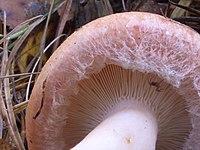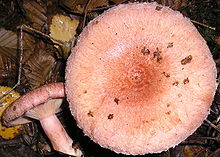Lactarius torminosus
| Lactarius torminosus | |
|---|---|

| |
| Scientific classification | |
| Domain: | Eukaryota |
| Kingdom: | Fungi |
| Division: | Basidiomycota |
| Class: | Agaricomycetes |
| Order: | Russulales |
| Family: | Russulaceae |
| Genus: | Lactarius |
| Species: | L. torminosus
|
| Binomial name | |
| Lactarius torminosus | |
| Synonyms[1] | |
|
List
| |
| Lactarius torminosus | |
|---|---|
| Gills on hymenium | |
| Cap is convex or depressed | |
| Hymenium is decurrent | |
| Stipe is bare | |
| Spore print is cream to yellow | |
| Ecology is mycorrhizal | |
| Edibility is not recommended | |
Lactarius torminosus, commonly known as the woolly milkcap or the bearded milkcap, is a large species of
A
Although it is valued for its peppery flavor and eaten after suitable preparation in Russia and Finland, the species is highly irritating to the digestive system when eaten raw. The toxins, also responsible for the strongly bitter or acrid taste, are destroyed by cooking. Studies have identified several chemicals present in the mushrooms, including ergosterol and derivatives thereof, and the pungent-tasting velleral.
Taxonomy and phylogeny
German naturalist
The
According to
A multi-gene
Description

The
The gills are subdecurrent (running only a small way down the length of the stem), close to crowded together, narrow, and sometimes forked near the stem. Their color is whitish, becoming pink-tinged, turning pale tan with age. The adult stem is 1.5–8 cm (0.6–3.1 in) long, 0.6–2 cm (0.2–0.8 in) thick, fragile, more or less equal in width throughout, and cylindrical or narrowed at the base. Its surface is dry, and either smooth to pruinose (covered with a very fine whitish powder on the surface). The color ranges from pale light pink to yellowish-tinged or slightly pinkish-orange to orange-white, sometimes spotted. The interior of the stem is firm, beige white, and filled with a soft pith, but it eventually becomes hollow.[22] Occasionally, white mycelium is visible at the base of the stem where it meets the ground.[23]
The fruit body
Microscopic characteristics
The spore print of L. torminosus is cream to pale yellow, and the spores 8–10.2 by 5.8–6.6 μm, roughly spherical to broadly elliptical in side view, and hyaline (translucent). Only the ornamentation on their surface is amyloid; it is partially reticulate (network-like) with interrupted ridges roughly 0.5–0.7 μm high, and a few isolated warts. Spores have a conspicuous apiculus, demarcating where it was once attached to the basidia via the sterigma. The basidia are four-spored, hyaline and club-shaped to cylindrical, measuring 30–47.7 by 7.3–8.2 μm.[22]
Variety nordmanensis
Lactarius nordmanensis was described by Alexander Smith in 1960 to account for a North American species closely resembling L. torminosus in appearance, but with a slightly larger range of spore sizes (9–11 by 6.5–8 μm). In contrast to the unchanging latex of L. torminosus, L. nordmanensis has whitish latex that slowly changes to pale yellow upon exposure to air; the latex also stains mushroom tissues and paper yellow.[25] Hesler and Smith reduced L. nordmanensis to the status of a variety under L. torminosus in 1979.[26] Lactarius torminosus var. nordmanensis has been recorded from California,[27] Idaho, Michigan, and Wisconsin in the United States, Quebec in Canada, and Switzerland. The variety resembles Lactarius pubescens var. betulae, but differs in its longer pleurocystidia, larger spores with slightly different spore ornamentation, and strongly burning acrid taste.[26] The holotype specimen of L. torminosus var. nordmanensis was collected by Smith in 1956 near Nordman, Idaho.[28]
Similar species
The woolly cap margin, pinkish tones in the cap, acrid latex, and association with birch are reliable field characteristics to help identify L. torminosus.

Edibility and toxicity
"Its taste is biting, worse than Cayenne pepper ... Unless he possessed a stomach built for the purpose, the man who touched such food as this would have a singularly bad time before him."
The intensely peppery taste of the raw mushroom can blister the tongue if sampled in excess.
Despite these reports of toxicity, L. torminosus mushrooms are prepared in Finland, Russia, and other northern and eastern European countries by parboiling, soaking in brine for several days, or pickling, after which they are valued for their peppery taste. In Norway, it is roasted and added to coffee.[15][31] Mushrooms are harvested for commercial sale in Finland.[40] The nutrient composition of Finnish specimens has been analyzed and found to contain the following components (as a percentage of dry weight): protein, 17.20%; phosphorus, 0.46%; calcium, 0.12%; magnesium, 0.09%; potassium, 2.97%; sodium 0.01%.[41]
Chemistry

The compound thought to be responsible for the toxicity of raw L. torminosus is the pungent-tasting
Fruit bodies of Lactarius torminosus contain a number of
Ecology and distribution

Lactarius torminosus is a
The species is found in northern
See also
- List of deadly fungi
- List of Lactarius species
References
- ^ a b c "Species synonymy: Lactarius torminosus (Schaeff.) Gray". Index Fungorum. CAB International. Archived from the original on 2012-10-07. Retrieved 2012-03-14.
- ^ Schäffer JC. (1774). Fungorum qui in Bavaria et Palatinatu circa Ratisbonam nascuntur icones [The Fungi that Grow in Bavaria and the Palatine, around Ratisbon] (in Latin and German). Vol. 4. Erlangen, Germany: Apud J.J. Palmium. pp. 7–8.
- ^ Bulliard JBF. (1781). Herbier de la France [Guide to the Herbs of France] (in French). Vol. 1. Paris, France: Chez l'auteur, Didot, Debure, Belin. pp. 1–48, plate 28.
- ^ Persoon Christian Hendrik (1799). Observationes mycologicae seu Descriptiones tam novorum, quam notabilium fungorum (in Latin). Leipzig, Germany: Gesnerus, Usterius & Wolfius. p. 42.
- ^ "Lactarius necator (Bull.) Pers. 1800". MycoBank. International Mycological Association. Retrieved 2012-04-22.
- ^ Kuntze O. (1898). Revisio generum plantarum (in Latin). Vol. 3. Leipzig, Germany: Arthur Felix. p. 489.
- ^ Kummer P. (1871). Der Führer in die Pilzkunde (in German). Zerbst, Germany: E. Luppe Staude. p. 125.
- ^ .
- ^ a b c Gray SF. (1821). A Natural Arrangement of British Plants. London, UK: Baldwin, Cradock, and Joy. p. 623.
- ^ ISBN 978-0-8131-9039-6.
- ^ Smith JE. (1824). The English Flora. Vol. 5. London, UK: Longman, Hurst, Rees, Orme, Brown, and Green. p. 24.
- ISBN 978-0-442-21998-7.
- ^ ISBN 978-0-395-91090-0.
- ^ ISBN 978-0-89815-388-0.
- ^ ISBN 978-0-89815-169-5.
- ^ "List of recommended English Names for Fungi in the UK" (PDF). British Mycological Society. 2003. Archived from the original (PDF) on 2011-07-16.
- ^ Hesler and Smith (1979), p. 237.
- PMID 21148854.
- ^ Buyck B, Hofstetter V, Eberhardt U, Verbeken A, Kauff F (2008). "Walking the thin line between Lactarius and Russula: the dilemma of Russula sect. Ochricompactae" (PDF). Fungal Diversity. 28: 15–40.
- .
- .
- ^ ISBN 978-0-88902-977-4.
- ^ Bessette et al. (2009), pp. 257–58.
- .
- S2CID 1928365.
- ^ a b Hesler and Smith (1979), pp. 277–78.
- JSTOR 3793204.
- ^ "Lactarius nordmanensis; Russulaceae (MICH5267)". Herbarium Fungus Collection Database. University of Michigan. Retrieved 2012-04-22.
- ^ Knudsen H, Borgen T (1994). "The Lactarius torminosus-group in Greenland". Mycologia Helvetica. 2: 49–56.
- ISBN 978-1-56579-192-3.
- ^ ISBN 978-0-226-72117-0.
- ^ Bessette et al. (2009), p. 249.
- ^ Coker WC. (1918). "Lactarias of North Carolina". Journal of the Elisha Mitchell Scientific Society. 34 (1–2): 1–62 (see p. 18).
- ^ Hesler and Smith (1979), p. 227.
- ISBN 978-1-58963-026-0.
- ISBN 978-0-660-10136-1.
- ISBN 978-0-471-62882-8.
- S2CID 31744331.
- ISBN 978-3-13-149591-4.
- ^ Veteläinen M, Huldén M, Pehu T (2008-11-06). State of Plant Genetic Resources for Food and Agriculture in Finland. Second Finnish National Report (PDF). Country Report on the State of Plant Genetic Resources for Food and Agriculture (Report). Sastamala, Finland: Ministry of Agriculture and Forestry. p. 14.
- ^ S2CID 28125328.
- JSTOR 3793113.
- .
- PMID 11281843.
- .
- .
- ^ Cotton S. "1-Octen-3-ol". Molecule of the Month. University of Bristol, School of Chemistry. Retrieved 2012-04-29.
- ISBN 978-0-8247-6956-7.
- S2CID 85392656.
- JSTOR 3760597.
- ISBN 978-0-919433-47-2.
- PMID 4773309.
Cited texts
- Bessette AR, Bessette AE, Harris DB (2009). Milk Mushrooms of North America: A Field Guide to the Genus Lactarius. Syracuse, New York: Syracuse University Press. ISBN 978-0-8156-3229-0.
- Hesler LR, Smith AH (1979). North American Species of Lactarius. Ann Arbor, Michigan: The University of Michigan Press. ISBN 978-0-472-08440-1.




